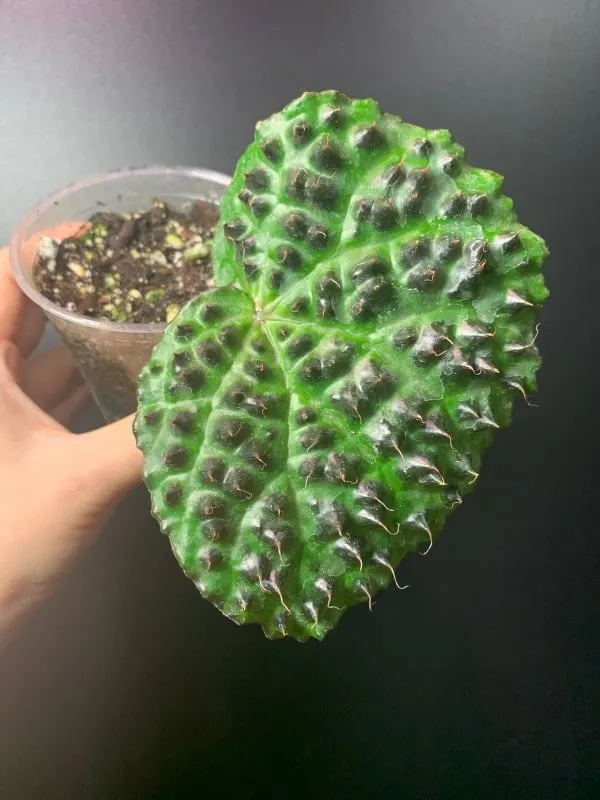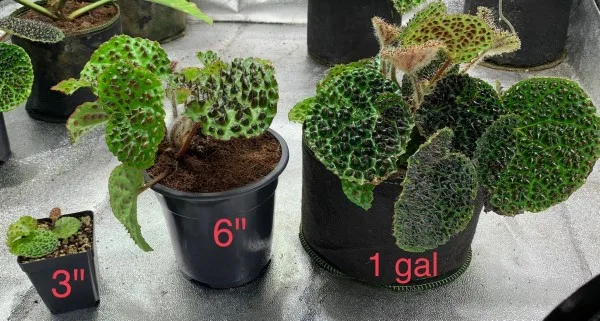Begonia Melanobullata is a unique plant species from the Vietnam cliffs. It shows some signature dark color bullate from a young age and needs to be mature before development.
The plant has green leaves covered in raised black spikes that are not sharp to touch. Also, it has one single, white and orange hair that grows. The plant is about 15cm tall, and it can be 10cm in the plastic nursery pot.

Care tips for Begonia Melanobullata
1. Soil
The soil for Begonia Melanobullata should be loose, light, and rich in organic matter. You can buy a ready-made mixture in the flower shops or prepare the optimal soil yourself.
Land for Begonia Melanobullata should consist of greenhouse soil for indoor plants, high-moor peat, fertilizers, preferably organic and fine squeak, which will perform a drainage function.
2. Lighting
Begonia Melanobullata loves light very much and is also unfriendly to change places. Therefore, before buying a flower, immediately decide on a site – ideally, a western or eastern window sill.
A lack of light (this applies to the northern rooms) will not allow the plant to develop as expected. And direct southern rays, on the contrary, can kill it.
3. Temperature
It is advisable to keep the temperature at 20 to 27 °C all the time. But the excellent adaptability of Begonia Melanobullata allows you to endure the inevitable summer heat. Although in this case, it will be necessary to humidify the air more often.
4. Watering
Regular watering is the key to abundant flowering for Begonia Melanobullata. This plant does not tolerate drying out of the soil and excessive moisture very well.
On average, Begonia Melanobullata needs to be watered twice a week and in the summer – every other day. The plant needs rest from late November to March, so watering once a week will suffice.
From this state, it is also taken out gradually, starting from March to April and until May, bringing watering to be normal. Excessive moisture is also dangerous for these flowers, drying out of the soil.
It threatens Begonia Melanobullata with root rot and becomes susceptible to such an unpleasant disease as powdery mildew.
5. Humidity
Moisture is needed in summer when the air is hot and in winter, when the air dries out the heating (and even more additional heaters). But do not rush to spray Begonia Melanobullata leaves from a spray bottle because this will not do the plant good because stains may form.
It is better to use special humidifiers. Or, as a good option, put the pot of begonias on a broader tray and place wetted pebbles around the pot (when they dry out, they need to be wetted again).
6. Fertilizer
It is crucial to feed Begonia Melanobullata before flowering. Excellent complimentary foods with the presence of potassium and phosphorus are good. In addition, complex fertilizer for flowering plants will not interfere with the appearance of buds.
Both complementary foods are added once in 2 weeks during the entire period. This is about a month and a half before flowering and then all the flowering time.
7. Top dressing
During flowering, the plant needs a larger amount of nutrients, so it would be advisable to fertilize the flower more than three times a month during the growing season.
For this, mineral mixtures for abundantly flowering plants are perfect. When Begonia Melanobullata does not bloom, it is enough to feed once a month.
8. Transplant
Begonia Melanobullata should only be transplanted if the previous pot for the plant is too small and the roots have filled the entire space in the container. In this case, you should take a pot a few centimeters larger, put drainage on the bottom, and then fill the plant with suitable soil.
When transplanting Begonia Melanobullata, you need to be very careful with its roots because it is very easy to damage them, and the recovery process takes a long time.

Propagation methods
a) Propagation by cuttings
This is the easiest and most efficient way. Cuttings with 3-4 leaf plates should be cut from an adult plant. To prevent rot from appearing on the cuts, it is recommended to treat them with charcoal. The resulting cuttings are planted in a mixture of leaf and peat soil and sand, equal proportions.
The container is placed in a well-lit and warm place. Water moderately and do not allow overflow. After about a month, we should expect the rooting of the cuttings. Then they can be planted in pots and grow a full-fledged bush of home begonia.
b) Propagation by leaves
When propagation by leaves, the entire leaf plate and its part is suitable. If the Begonia Melanobullata is propagated as a whole leaf, then the veins must be cut on the underside of the leaf.
Then the sheet plate should be laid with the notched side on the surface of moistened sand (sand for disinfection should be calcined in advance). Watering, in this case, occurs through the pallet because.
The sheet itself cannot be wetted in any way; otherwise, it will rot. After about eight weeks, roots will appear from the incised places.
c) Propagation by seeds
Although growing Begonia Melanobullata from seeds is considered unpopular, it is relatively simple and labor-intensive. When the flowering period is over, you should collect the seeds and save them until February or March.
During this period, sowing is carried out, evenly distributing the seeds over the soil’s surface. After that, the bed should be sprayed with water, covered with film or glass, and placed in a warm, well-lit place.
Seedlings should be sprayed daily with water or watered through a pan. When the first shoots appear, the shelter is removed, and after the formation of 3-4 true leaves, the sprouts should be picked in separate containers.
In two months, the sprouts will get stronger, and they can be transplanted into a permanent pot. With proper care and good lighting, the flowering of a crop grown from seeds begins in the first year.
Conclusion
Begonia Melanobullata is a slow-growing plant with ovate to round leaves from the Vietnam cliffs. Its leaves are green, covered in beautiful structures known as bullae. It does well in high humidity and bright, indirect light but require some airflow because it originated from the limestone cliffs.
